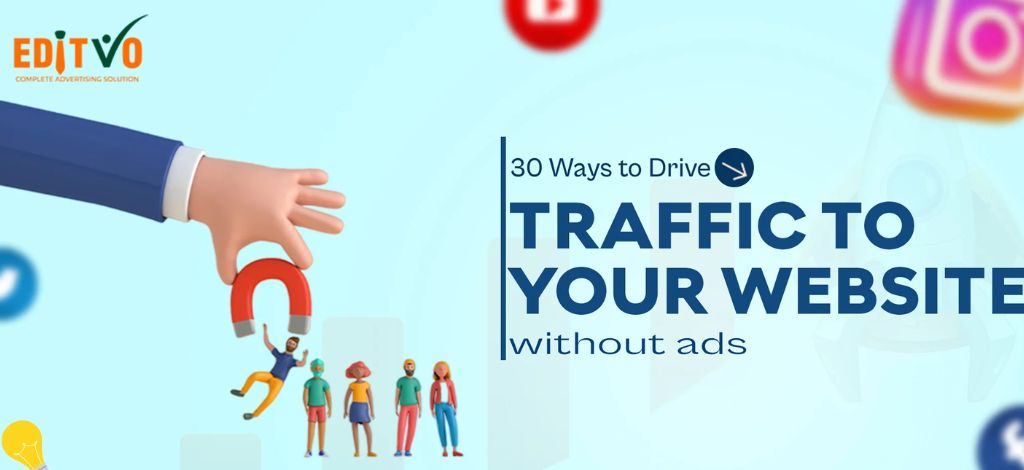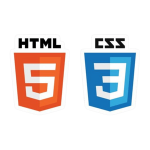
30 Ways to Drive Traffic to Your Website Without Ads
Driving traffic to your website is essential for growing your online presence, attracting new customers, and increasing sales. But you don’t always need to spend money on ads to bring people to your site. There are many simple and effective ways to increase website traffic without paying for advertisements. Below are 30 easy ways to get more visitors to your website without spending money on ads.
1. Content Creation
Creating valuable content, known as Content Creation, is one of the best ways to bring people to your website. Content can be anything like blog posts, videos, images, or podcasts. The key is to create things that people find interesting, helpful, or entertaining. If you regularly post high-quality content, more people will visit your website to see what you have to offer.
Steps to Apply:
- Identify your target audience and what they are interested in.
- Create a content plan with topics that provide value to your audience
- Use a consistent publishing schedule, such as weekly blog posts.
- Promote your content on social media and through email newsletters
2. Topic Expertise
When you know a lot about a subject, people trust you and are more likely to visit your website. This is called Topic Expertise. You can show your expertise by writing detailed blog posts, sharing tips, or giving advice in your area of knowledge. The more you share useful information, the more people will come to your website to learn from you.
Steps to Apply:
- Choose a niche or specific topic you are knowledgeable about.
- Write in-depth articles that answer common questions in your niche.
- Update your content regularly to keep it relevant and accurate.
- Share your expertise in online forums or social media groups related to your niche.
3. Organic Social Media
Organic Social Media means using social media platforms like Facebook, Instagram, or Twitter to promote your website for free. By regularly posting interesting content on these platforms, you can attract more visitors to your site. You don’t have to pay for ads—just share your content, interact with followers, and use popular hashtags to reach more people.
Steps to Apply:
- Set up profiles on social media platforms where your audience spends time.
- Post engaging content regularly, including links to your website.
- Use relevant hashtags to increase your content’s visibility.
- Respond to comments and messages to build a community around your brand.
4. Website Analysis
Website Analysis involves looking at how people use your website. Tools like Google Analytics can show you which pages are popular, where visitors come from, and how long they stay on your site. By understanding this data, you can make your website better, which will encourage more people to visit.
Steps to Apply:
- Set up Google Analytics on your website.
- Regularly review reports on traffic sources, user behaviour, and conversions.
- Identify pages with high bounce rates and improve their content or design.
5. Influencers
Influencers are people who have a large following online. They can help promote your website to a bigger audience. You can ask influencers to share your content or mention your website. When they do, their followers might visit your site, increasing your traffic.
Steps to Apply:
- Identify influencers in your niche with a large, engaged following.
- Reach out to them with a proposal to collaborate or feature your content.
- Offer something of value in exchange, like free products or exclusive content.
- Track the traffic and engagement you receive from their promotions.
6. Email List Building
Email List Building is the process of collecting email addresses from people who visit your website. You can then send them updates, newsletters, or special offers. When you send regular emails to your list, you remind people to visit your website again, which helps increase your traffic.
Steps to Apply:
- Add a signup form on your website to collect email addresses.
- Offer a freebie, like an e-book or discount, as an incentive to sign up.
- Send regular newsletters with valuable content and links to your website.
- Segment your email list based on interests to send more personalized content.
7. Community Engagement
Community Engagement means participating in online groups and forums where people talk about topics related to your website. By joining the conversation and sharing your knowledge, you can direct people to your website. This helps you build relationships with potential visitors.
Steps to Apply:
- Join relevant forums, social media groups, or online communities.
- Participate in discussions by offering helpful advice or answering questions.
- links to your content when it’s relevant to the conversation.
- Build relationships with other members by regularly contributing to the community.
8. On-Page SEO
On-Page SEO (Search Engine Optimization) is about making sure your website is easy for search engines like Google to find. This includes using the right keywords, making sure your website is mobile friendly, and creating clear, easy to read content. Good SEO helps your website appear higher in search results, which brings more visitors.
Steps to Apply:
- keywords related to your business and include them in your content.
- Ensure your website is mobile-friendly and loads quickly.
- Use clear headings, short paragraphs, and bullet points to make your content easy to read.
- Include meta titles and descriptions for each page to improve search engine rankings.
9. Quality Backlinks
A Quality Backlink is when another website links to your site. This is like a vote of confidence that tells search engines your website is trustworthy. The more quality backlinks you have, the higher your website will rank in search results, which can bring more traffic.
Steps to Apply:
- guest posts for other blogs in your niche and include links to your site.
- Create high-quality content that others will want to link to.
- Reach out to websites that have mentioned your brand but haven’t linked to you.
- Build relationships with other bloggers and website owners to earn more backlinks.
10. Video Marketing
Video Marketing involves creating and sharing videos to attract visitors to your website. Videos are a popular way to communicate because they are easy to watch and share. You can post videos on YouTube, social media, or directly on your website. This can help attract more visitors who prefer watching videos over reading text.
Steps to Apply:
- Create short, engaging videos that address your audience’s needs or interests.
- Upload videos to platforms like YouTube and embed them on your website.
- Share your videos on social media and encourage followers to share them.
- Include a call to action in your videos, directing viewers to your website
11. Content Repurposing
Content Repurposing is about taking content you’ve already created and using it in different ways. For example, you can turn a blog post into a video or an infographic. This allows you to reach different types of people and keep your content fresh, which can help bring more visitors to your website.
Steps to Apply:
- Review your existing content and identify pieces that can be repurposed.
- Convert blog posts into videos, infographics, or podcasts.
- Share the repurposed content on different platforms to reach a new audience.
- Update the original content to include links to the repurposed versions
12. SEO Tools
Using SEO Tools like SEMrush or Ahrefs can help you find the right keywords to use in your content. These tools show you what people are searching for and how you can improve your website to rank higher in search results. By using these tools, you can make your website more attractive to search engines and get more visitors.
Steps to Apply:
- Sign up for an SEO tool and use it to research keywords related to your business.
- Analyze your website’s current SEO performance and identify areas for improvement.
- Use the tool to find and fix technical SEO issues, such as broken links or slow page load times.
- Track your progress over time to see how your SEO efforts are paying off.
13. Historical Optimization
Historical Optimization is about updating old content on your website to make it more relevant today. You can add new information, update links, or improve the formatting. This can help your older content rank higher in search results again, bringing in more traffic.
Steps to Apply:
- Identify old blog posts or pages that are still relevant but may need updates.
- Add new information, images, or links to refresh the content.
- Update the keywords and improve the on-page SEO for these posts.
- Promote the updated content on social media and through your email list.
14. Voice Search Optimization
Voice Search Optimization is making sure your website content is easy to find when people use voice search tools like Siri or Alexa. People tend to use more natural language when speaking, so it’s important to use long tail keywords (longer phrases) that match how people talk. This can help attract visitors who use voice search.
Steps to Apply:
- Research long tail keywords that match how people ask questions in voice searches.
- Update your content to include these natural language phrases.
- Optimize for local search queries, as many voice searches are location-based.
- Ensure your website is mobile-friendly, as voice searches often come from mobile devices.
15. Local SEO
If your business serves a specific area, Local SEO is crucial. This involves making sure your website shows up in local search results, like when someone searches for “restaurants near me.” You can improve local SEO by including your location in your content and signing up for Google My Business. This helps local customers find you, bringing more traffic to your site.
Steps to Apply:
- Create and verify your Google My Business listing.
- Include your business address, phone number, and operating hours on your website.
- Add local keywords to your website content, such as city or neighborhood names.
- Encourage customers to leave reviews on Google, which can boost your local search ranking.
16. QR Codes
QR Codes are those black-and-white squares you can scan with your phone to visit a website. You can put QR codes on your business cards, flyers, or posters to make it easy for people to visit your website. This is a simple way to connect your offline marketing efforts with online traffic.
Step By Step Guidance
Step 1: Generate QR codes that link to specific pages on your website.
Step 2: Print these codes on business cards, flyers, or product packaging.
Step 3: Place the QR codes in places where people can easily scan them.
17. A/B Testing
A/B Testing involves trying out two different versions of a webpage to see which one performs better. For example, you might test two different headlines or images to see which one gets more clicks. By doing this, you can find out what works best and make your website more effective at attracting visitors.
Step By Step Guidance
- Step 1: Choose a page element to test, like a headline or call-to-action button.
- Step 2: Create two versions (A and B) and show them to different visitors.
- Step 3: Analyze the results and choose the version that performs better.
18. Internal Linking
Internal Linking is when you link from one page on your website to another. This helps guide visitors to other content they might find interesting and keeps them on your site longer. It also helps search engines understand your site’s structure, which can improve your SEO and bring more traffic.
Steps to Apply:
Step 1: Identify related content within your website.
Step 2: Add links within your articles to guide visitors to other relevant pages.
Step 3: Regularly check for broken links and update them.
19. Technical SEO
Technical SEO is about making sure your website runs smoothly. This includes things like how fast your website loads, whether it works well on mobile devices, and making sure your site is secure (HTTPS). A technically sound website provides a better experience for visitors, which can help bring more traffic.
Steps to Apply:
Step 1: Perform a technical SEO audit to identify issues.
Step 2: Fix any problems with site speed, mobile-friendliness, or security (HTTPS).
Step 3: Ensure your site is easy to crawl by search engines with a proper sitemap.
20. Community Building
Community Building is about creating a loyal group of followers who regularly visit your website. You can build a community through forums, social media groups, or even a comments section on your blog. When people feel connected to your website, they’re more likely to visit regularly and tell others about it.
Steps to Apply:
Step 1: Create a space for your audience to interact, such as a forum or social media group.
Step 2: Encourage discussions by asking questions and sharing insights.
Step 3: Promote your website within the community to drive traffic.
21. Content Offers
Content Offers are free resources you give away in exchange for someone’s email address. This could be an e-book, a guide, or a checklist. By offering something valuable, you encourage visitors to sign up for your email list, which means you can send them more information that brings them back to your website.
Steps to Apply:
Step 1: Create a valuable resource, such as an e-book or checklist.
Step 2: Offer this resource for free in exchange for an email signup.
Step 3: Promote the content offered through your website and social media.
22. Media Coverage & Public Relations
Getting Media Coverage and Public Relations means being featured in newspapers, magazines, or blogs. When people read about you in a trusted source, they are more likely to visit your website. You can reach out to journalists, write press releases, or even start a blog to attract media attention.
Steps to Apply:
Step 1: Write press releases about your business or website.
Step 2: Contact journalists and bloggers who might be interested in your story.
Step 3: Share any media mentions on your website and social channels
23. Social Share Buttons
Adding Social Share Buttons to your website makes it easy for visitors to share your content on social media. When people share your content, it reaches a broader audience, which can bring more visitors to your website
Steps to Apply:
Step 1: Add social share buttons to your blog posts and web pages.
Step 2: Make sure the buttons are easy to find and use.
Step 3: Encourage visitors to share your content with their networks.
24. CTR Optimization
CTR Optimization means making your website’s search engine listing more attractive, so people are more likely to click on it. This includes writing a catchy title and description that encourages people to visit your site. By improving your click-through rate, you can bring more traffic to your website.
Steps to Apply:
Step 1: Write compelling meta titles and descriptions for your web pages.
Step 2: Use action words and include keywords to make them stand out in search results.
Step 3: Monitor your click-through rate and adjust your content if needed.
25. Academy & Knowledge Base Posts
Creating Academy and Knowledge Base Posts means offering educational content on your website. This can be in the form of tutorials, how to guide, or answers to frequently asked questions. By helping visitors learn something new, you can attract more people to your site.
Step 1: Identify common questions or problems your audience faces.
Step 2: Create detailed guides or tutorials that provide solutions.
Step 3: Organize these posts in an easily accessible section of your website.
26. Podcasts
Podcasts are audio recordings that you can share online. Hosting a podcast or being a guest on someone else’s podcast is a great way to reach new audiences. Include a link to your website in the podcast notes or mention it during the show to drive traffic to your site.
Steps to Apply:
Step 1: Choose topics relevant to your audience and plan episodes.
Step 2: Record, edit, and publish your podcast episodes.
Step 3: Promote your podcast on your website, social media, and podcast directories.
27. Online Courses
Offering Online Courses is another way to attract visitors to your website. You can create courses on topics related to your business and share them online. People who want to learn more will visit your website to take the course, increasing your traffic.
Step 1: Select a topic that your audience wants to learn about.
Step 2: Create course materials, including videos, worksheets, and quizzes.
Step 3: Host the course on your website and promote it to attract participants.
28. Giveaways and Contests
Running Giveaways and Contests is a fun way to engage people and bring them to your website. You can offer a prize in exchange for visitors entering the contest, sharing the content, or signing up for your email list. This can quickly increase your website traffic as people share the contest with their friends.
Steps to Apply:
Step 1: Decide on a prize that will attract your target audience.
Step 2: Set up contest rules, such as requiring a visit to your website or social media share to enter.
Step 3: Promote the contest across all your channels.
29. Collaboration and Partnerships
Collaboration and Partnerships involve working with other businesses or influencers to promote your website. You can co-create content, host events, or simply share each other’s work. This allows you to reach a larger audience and drive more traffic to your site.
Step 1: Identify businesses or influencers who share a similar audience.
Step 2: Reach out to propose a collaboration, like co-hosting an event or creating content together.
Step 3: Promote the collaboration on both your website and your partner’s platforms.
30. Online Directories and Listings
Finally, submitting your website to Online Directories and Listings can help people find you more easily. These directories list businesses by category and location, making it easier for potential customers to discover your website.
Step By Step Guidance
Step 1: Find online directories relevant to your industry.
Step 2: Submit your business information and website link.
Step 3: Regularly update your listings to keep the information accurate
Conclusion
Bringing visitors to your website without spending money on ads is entirely possible if you use these 30 strategies. By focusing on content creation, engaging with communities, optimizing your website for search engines, and leveraging social media, you can steadily increase your traffic. Remember, consistency is key, keep applying these methods, and over time, you’ll see more and more visitors coming to your website.
FAQS
Content Creation involves producing valuable and engaging material like blog posts, videos, or images that attract and retain visitors. It’s crucial for driving traffic because it provides information and entertainment that can make your website appealing to users and encourage them to visit regularly.
Showing Topic Expertise means sharing detailed and knowledgeable content on a specific subject. When you consistently provide valuable insights and information, people view you as an authority in that field, which can increase trust and drive more traffic to your website.
Organic Social Media refers to using social media platforms without paying for ads. By regularly posting interesting content, engaging with followers, and using relevant hashtags, you can attract more people to visit your website. It’s a free way to increase your site’s visibility.
Website Analysis involves examining how users interact with your website through tools like Google Analytics. Understanding which pages are popular and how visitors find your site allows you to make improvements, enhancing user experience and potentially increasing traffic.
Influencers are individuals with a large online following. By partnering with them to promote your content or mention your website, you can reach their audience and potentially drive more traffic to your site.
Technologies We Use









Designing Services
- Graphic Designing
- Website Designing
- Video Marketing
Digital Services
Contact Us
- Phone Number: +91 9137351850
- Phone Number: +91 9821682967
- Email: info@editvo.com
- Location: A-34C, Sector 49, Noida, UP, 201307 (India)
©2025, Editvo - Complete Advertising Solution . All Rights Reserved.
Seeking Expert Guidance?
Consult with Us for Top-Tier Services . We Guarantee That You Will Be Able To Have Any Issue Resolved Successfully Within 24 Hours.
Unlock Your Website's Potential with an Expert SEO Audit Report
Fill out the form to get a detailed report

